HI5020 Corporate Accounting: Comparative Analysis of Two Banks
VerifiedAdded on 2023/06/07
|17
|4501
|275
Report
AI Summary
This report provides a comparative analysis of Westpac Banking Corporation and Commonwealth Bank, two major Australian banks listed on the ASX, focusing on their financial performance and position. The analysis covers key areas including owner's equity, cash flow statements, other comprehensive income, and corporate income tax accounting. The report examines specific items within each financial statement, such as share capital, retained profits, and cash flows from operating, investing, and financing activities. It also compares the debt and equity positions of the two banks, their effective tax rates, and deferred tax assets/liabilities. The analysis highlights differences in financial strategies and performance indicators between Westpac and Commonwealth Bank, providing insights into their financial health and operational efficiency. Desklib offers a platform for students to access similar solved assignments and study tools.

Corporate Accounting 1
CORPORATE ACCOUNTING
Author
Course Title
Professor
City
Date
CORPORATE ACCOUNTING
Author
Course Title
Professor
City
Date
Paraphrase This Document
Need a fresh take? Get an instant paraphrase of this document with our AI Paraphraser
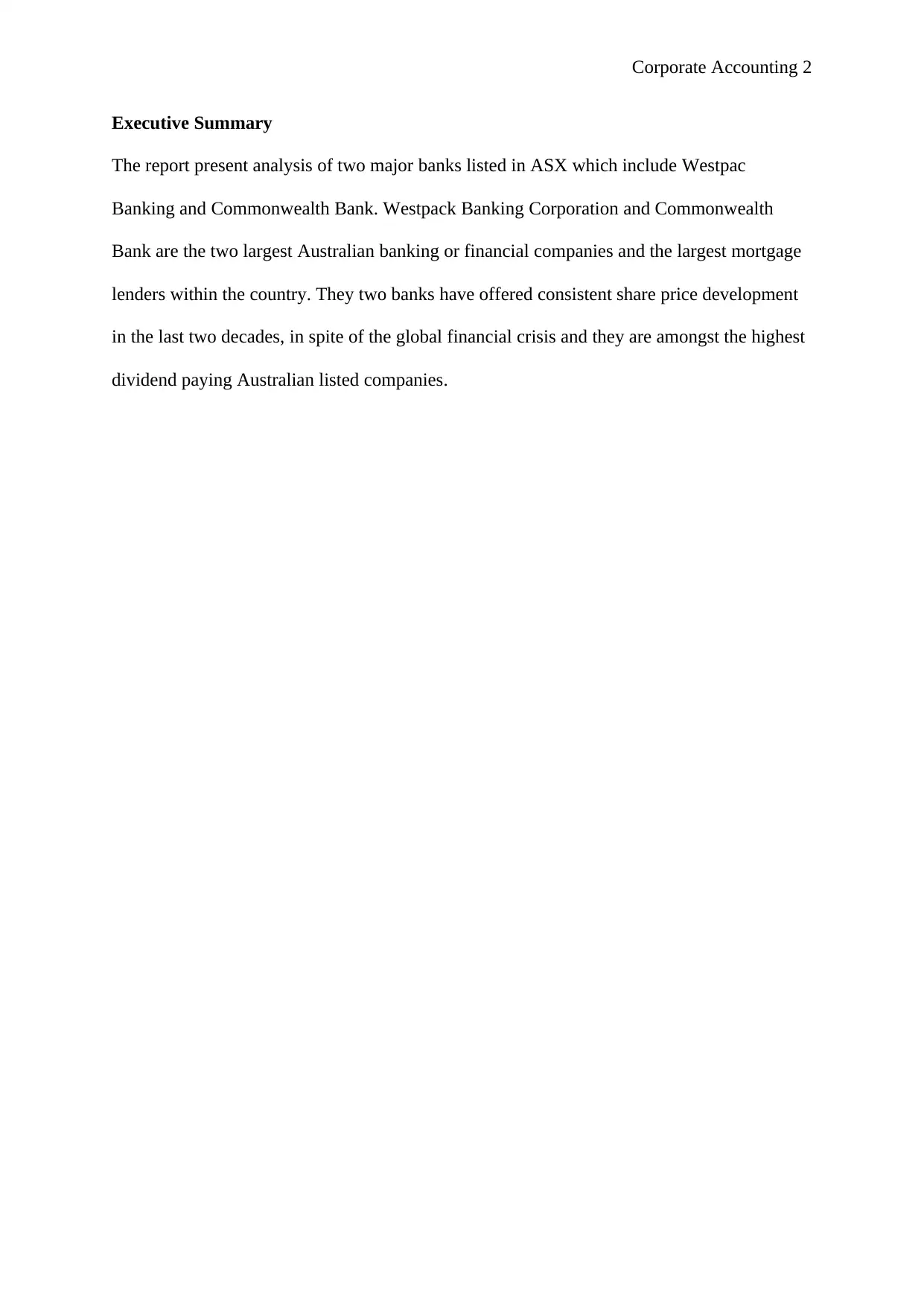
Corporate Accounting 2
Executive Summary
The report present analysis of two major banks listed in ASX which include Westpac
Banking and Commonwealth Bank. Westpack Banking Corporation and Commonwealth
Bank are the two largest Australian banking or financial companies and the largest mortgage
lenders within the country. They two banks have offered consistent share price development
in the last two decades, in spite of the global financial crisis and they are amongst the highest
dividend paying Australian listed companies.
Executive Summary
The report present analysis of two major banks listed in ASX which include Westpac
Banking and Commonwealth Bank. Westpack Banking Corporation and Commonwealth
Bank are the two largest Australian banking or financial companies and the largest mortgage
lenders within the country. They two banks have offered consistent share price development
in the last two decades, in spite of the global financial crisis and they are amongst the highest
dividend paying Australian listed companies.
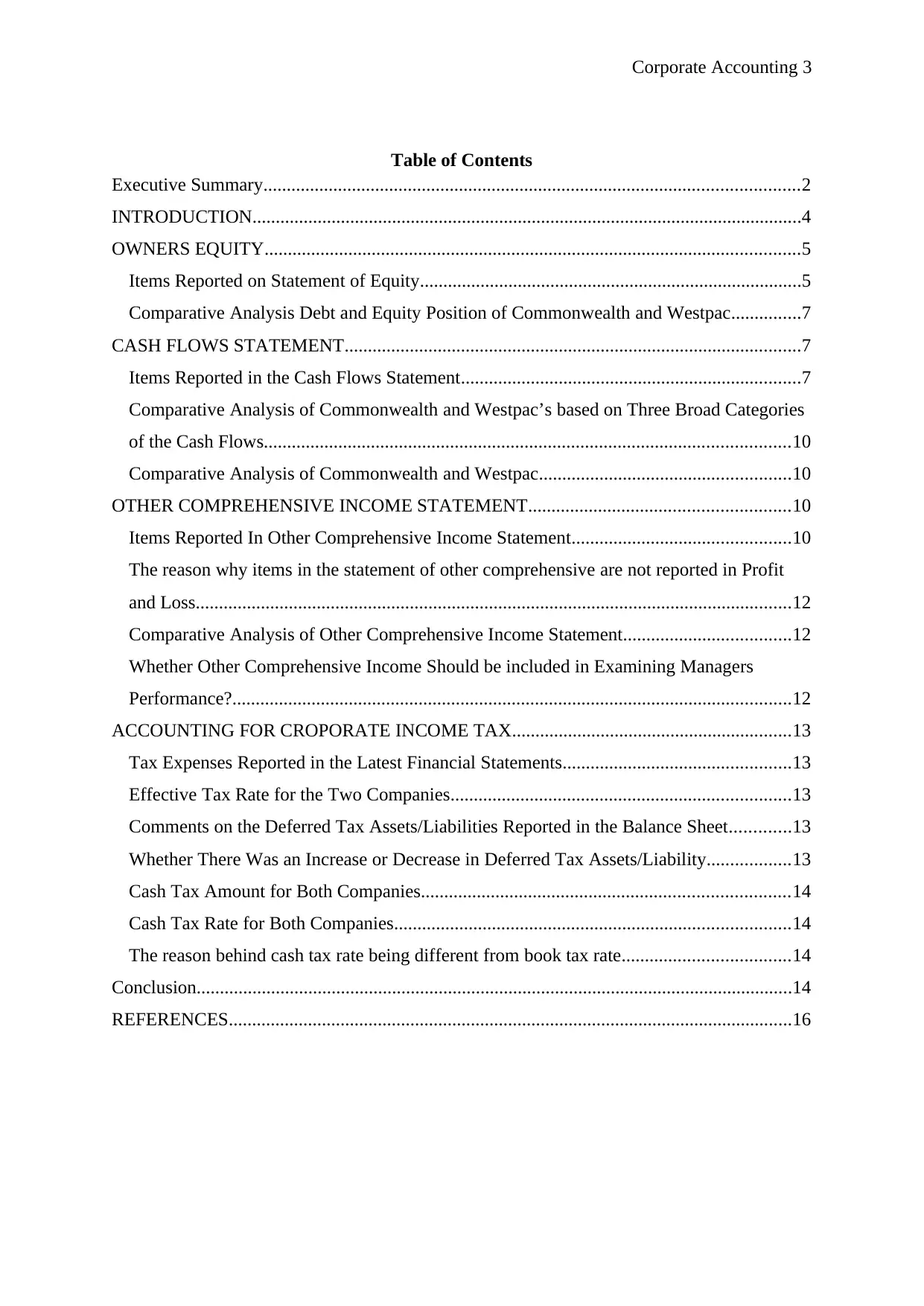
Corporate Accounting 3
Table of Contents
Executive Summary...................................................................................................................2
INTRODUCTION......................................................................................................................4
OWNERS EQUITY...................................................................................................................5
Items Reported on Statement of Equity..................................................................................5
Comparative Analysis Debt and Equity Position of Commonwealth and Westpac...............7
CASH FLOWS STATEMENT..................................................................................................7
Items Reported in the Cash Flows Statement.........................................................................7
Comparative Analysis of Commonwealth and Westpac’s based on Three Broad Categories
of the Cash Flows.................................................................................................................10
Comparative Analysis of Commonwealth and Westpac......................................................10
OTHER COMPREHENSIVE INCOME STATEMENT........................................................10
Items Reported In Other Comprehensive Income Statement...............................................10
The reason why items in the statement of other comprehensive are not reported in Profit
and Loss................................................................................................................................12
Comparative Analysis of Other Comprehensive Income Statement....................................12
Whether Other Comprehensive Income Should be included in Examining Managers
Performance?........................................................................................................................12
ACCOUNTING FOR CROPORATE INCOME TAX............................................................13
Tax Expenses Reported in the Latest Financial Statements.................................................13
Effective Tax Rate for the Two Companies.........................................................................13
Comments on the Deferred Tax Assets/Liabilities Reported in the Balance Sheet.............13
Whether There Was an Increase or Decrease in Deferred Tax Assets/Liability..................13
Cash Tax Amount for Both Companies...............................................................................14
Cash Tax Rate for Both Companies.....................................................................................14
The reason behind cash tax rate being different from book tax rate....................................14
Conclusion................................................................................................................................14
REFERENCES.........................................................................................................................16
Table of Contents
Executive Summary...................................................................................................................2
INTRODUCTION......................................................................................................................4
OWNERS EQUITY...................................................................................................................5
Items Reported on Statement of Equity..................................................................................5
Comparative Analysis Debt and Equity Position of Commonwealth and Westpac...............7
CASH FLOWS STATEMENT..................................................................................................7
Items Reported in the Cash Flows Statement.........................................................................7
Comparative Analysis of Commonwealth and Westpac’s based on Three Broad Categories
of the Cash Flows.................................................................................................................10
Comparative Analysis of Commonwealth and Westpac......................................................10
OTHER COMPREHENSIVE INCOME STATEMENT........................................................10
Items Reported In Other Comprehensive Income Statement...............................................10
The reason why items in the statement of other comprehensive are not reported in Profit
and Loss................................................................................................................................12
Comparative Analysis of Other Comprehensive Income Statement....................................12
Whether Other Comprehensive Income Should be included in Examining Managers
Performance?........................................................................................................................12
ACCOUNTING FOR CROPORATE INCOME TAX............................................................13
Tax Expenses Reported in the Latest Financial Statements.................................................13
Effective Tax Rate for the Two Companies.........................................................................13
Comments on the Deferred Tax Assets/Liabilities Reported in the Balance Sheet.............13
Whether There Was an Increase or Decrease in Deferred Tax Assets/Liability..................13
Cash Tax Amount for Both Companies...............................................................................14
Cash Tax Rate for Both Companies.....................................................................................14
The reason behind cash tax rate being different from book tax rate....................................14
Conclusion................................................................................................................................14
REFERENCES.........................................................................................................................16
⊘ This is a preview!⊘
Do you want full access?
Subscribe today to unlock all pages.

Trusted by 1+ million students worldwide
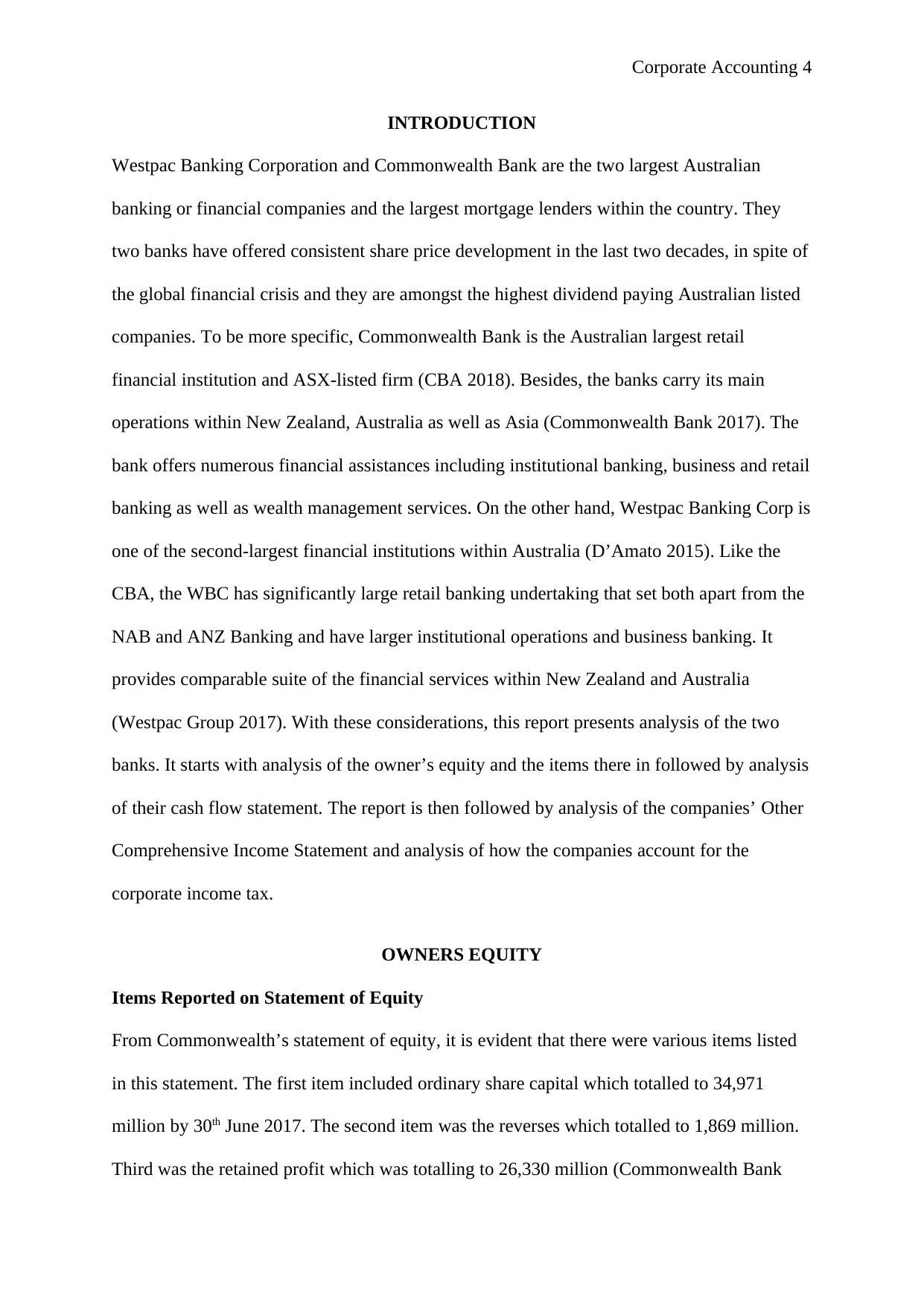
Corporate Accounting 4
INTRODUCTION
Westpac Banking Corporation and Commonwealth Bank are the two largest Australian
banking or financial companies and the largest mortgage lenders within the country. They
two banks have offered consistent share price development in the last two decades, in spite of
the global financial crisis and they are amongst the highest dividend paying Australian listed
companies. To be more specific, Commonwealth Bank is the Australian largest retail
financial institution and ASX-listed firm (CBA 2018). Besides, the banks carry its main
operations within New Zealand, Australia as well as Asia (Commonwealth Bank 2017). The
bank offers numerous financial assistances including institutional banking, business and retail
banking as well as wealth management services. On the other hand, Westpac Banking Corp is
one of the second-largest financial institutions within Australia (D’Amato 2015). Like the
CBA, the WBC has significantly large retail banking undertaking that set both apart from the
NAB and ANZ Banking and have larger institutional operations and business banking. It
provides comparable suite of the financial services within New Zealand and Australia
(Westpac Group 2017). With these considerations, this report presents analysis of the two
banks. It starts with analysis of the owner’s equity and the items there in followed by analysis
of their cash flow statement. The report is then followed by analysis of the companies’ Other
Comprehensive Income Statement and analysis of how the companies account for the
corporate income tax.
OWNERS EQUITY
Items Reported on Statement of Equity
From Commonwealth’s statement of equity, it is evident that there were various items listed
in this statement. The first item included ordinary share capital which totalled to 34,971
million by 30th June 2017. The second item was the reverses which totalled to 1,869 million.
Third was the retained profit which was totalling to 26,330 million (Commonwealth Bank
INTRODUCTION
Westpac Banking Corporation and Commonwealth Bank are the two largest Australian
banking or financial companies and the largest mortgage lenders within the country. They
two banks have offered consistent share price development in the last two decades, in spite of
the global financial crisis and they are amongst the highest dividend paying Australian listed
companies. To be more specific, Commonwealth Bank is the Australian largest retail
financial institution and ASX-listed firm (CBA 2018). Besides, the banks carry its main
operations within New Zealand, Australia as well as Asia (Commonwealth Bank 2017). The
bank offers numerous financial assistances including institutional banking, business and retail
banking as well as wealth management services. On the other hand, Westpac Banking Corp is
one of the second-largest financial institutions within Australia (D’Amato 2015). Like the
CBA, the WBC has significantly large retail banking undertaking that set both apart from the
NAB and ANZ Banking and have larger institutional operations and business banking. It
provides comparable suite of the financial services within New Zealand and Australia
(Westpac Group 2017). With these considerations, this report presents analysis of the two
banks. It starts with analysis of the owner’s equity and the items there in followed by analysis
of their cash flow statement. The report is then followed by analysis of the companies’ Other
Comprehensive Income Statement and analysis of how the companies account for the
corporate income tax.
OWNERS EQUITY
Items Reported on Statement of Equity
From Commonwealth’s statement of equity, it is evident that there were various items listed
in this statement. The first item included ordinary share capital which totalled to 34,971
million by 30th June 2017. The second item was the reverses which totalled to 1,869 million.
Third was the retained profit which was totalling to 26,330 million (Commonwealth Bank
Paraphrase This Document
Need a fresh take? Get an instant paraphrase of this document with our AI Paraphraser
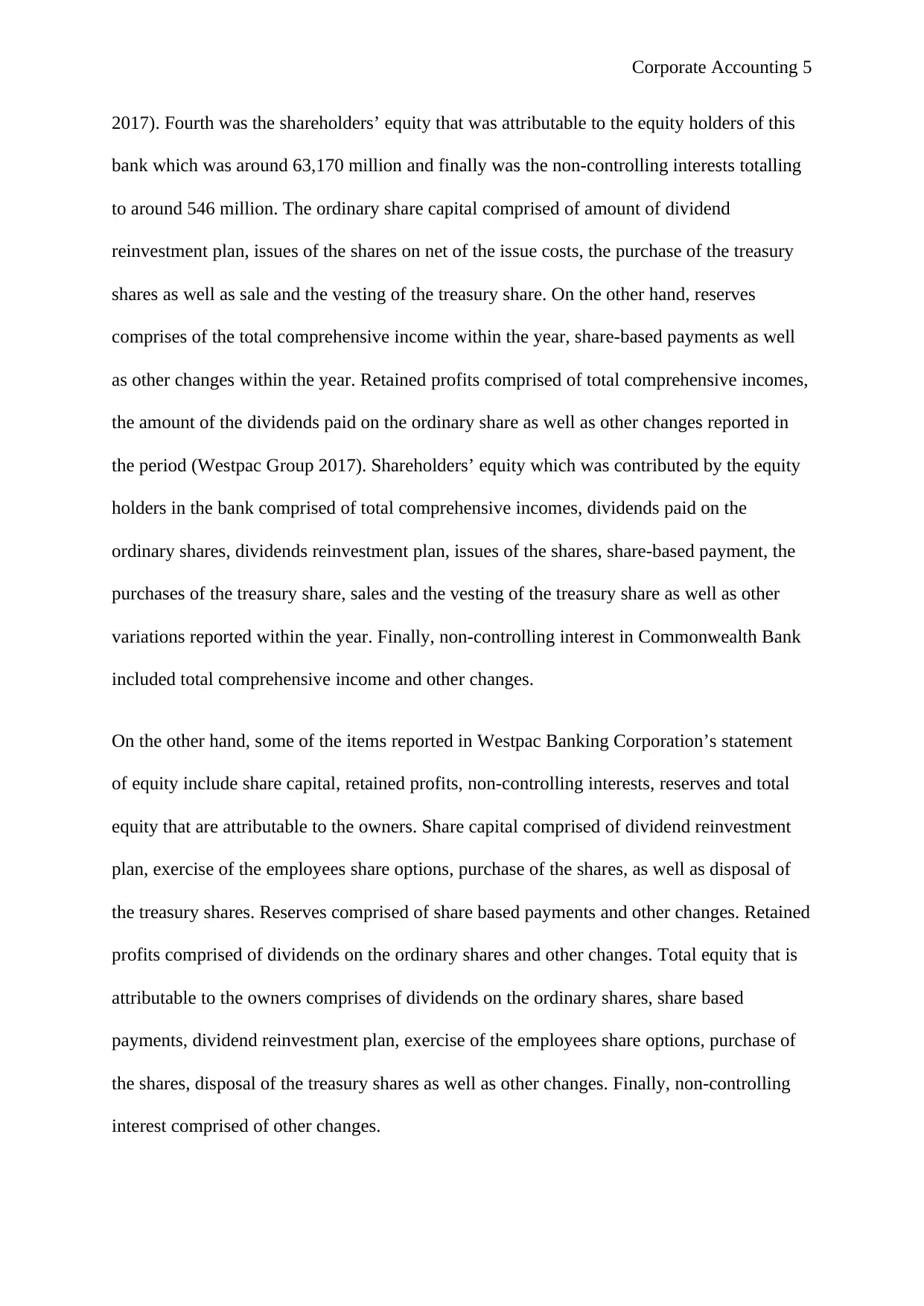
Corporate Accounting 5
2017). Fourth was the shareholders’ equity that was attributable to the equity holders of this
bank which was around 63,170 million and finally was the non-controlling interests totalling
to around 546 million. The ordinary share capital comprised of amount of dividend
reinvestment plan, issues of the shares on net of the issue costs, the purchase of the treasury
shares as well as sale and the vesting of the treasury share. On the other hand, reserves
comprises of the total comprehensive income within the year, share-based payments as well
as other changes within the year. Retained profits comprised of total comprehensive incomes,
the amount of the dividends paid on the ordinary share as well as other changes reported in
the period (Westpac Group 2017). Shareholders’ equity which was contributed by the equity
holders in the bank comprised of total comprehensive incomes, dividends paid on the
ordinary shares, dividends reinvestment plan, issues of the shares, share-based payment, the
purchases of the treasury share, sales and the vesting of the treasury share as well as other
variations reported within the year. Finally, non-controlling interest in Commonwealth Bank
included total comprehensive income and other changes.
On the other hand, some of the items reported in Westpac Banking Corporation’s statement
of equity include share capital, retained profits, non-controlling interests, reserves and total
equity that are attributable to the owners. Share capital comprised of dividend reinvestment
plan, exercise of the employees share options, purchase of the shares, as well as disposal of
the treasury shares. Reserves comprised of share based payments and other changes. Retained
profits comprised of dividends on the ordinary shares and other changes. Total equity that is
attributable to the owners comprises of dividends on the ordinary shares, share based
payments, dividend reinvestment plan, exercise of the employees share options, purchase of
the shares, disposal of the treasury shares as well as other changes. Finally, non-controlling
interest comprised of other changes.
2017). Fourth was the shareholders’ equity that was attributable to the equity holders of this
bank which was around 63,170 million and finally was the non-controlling interests totalling
to around 546 million. The ordinary share capital comprised of amount of dividend
reinvestment plan, issues of the shares on net of the issue costs, the purchase of the treasury
shares as well as sale and the vesting of the treasury share. On the other hand, reserves
comprises of the total comprehensive income within the year, share-based payments as well
as other changes within the year. Retained profits comprised of total comprehensive incomes,
the amount of the dividends paid on the ordinary share as well as other changes reported in
the period (Westpac Group 2017). Shareholders’ equity which was contributed by the equity
holders in the bank comprised of total comprehensive incomes, dividends paid on the
ordinary shares, dividends reinvestment plan, issues of the shares, share-based payment, the
purchases of the treasury share, sales and the vesting of the treasury share as well as other
variations reported within the year. Finally, non-controlling interest in Commonwealth Bank
included total comprehensive income and other changes.
On the other hand, some of the items reported in Westpac Banking Corporation’s statement
of equity include share capital, retained profits, non-controlling interests, reserves and total
equity that are attributable to the owners. Share capital comprised of dividend reinvestment
plan, exercise of the employees share options, purchase of the shares, as well as disposal of
the treasury shares. Reserves comprised of share based payments and other changes. Retained
profits comprised of dividends on the ordinary shares and other changes. Total equity that is
attributable to the owners comprises of dividends on the ordinary shares, share based
payments, dividend reinvestment plan, exercise of the employees share options, purchase of
the shares, disposal of the treasury shares as well as other changes. Finally, non-controlling
interest comprised of other changes.
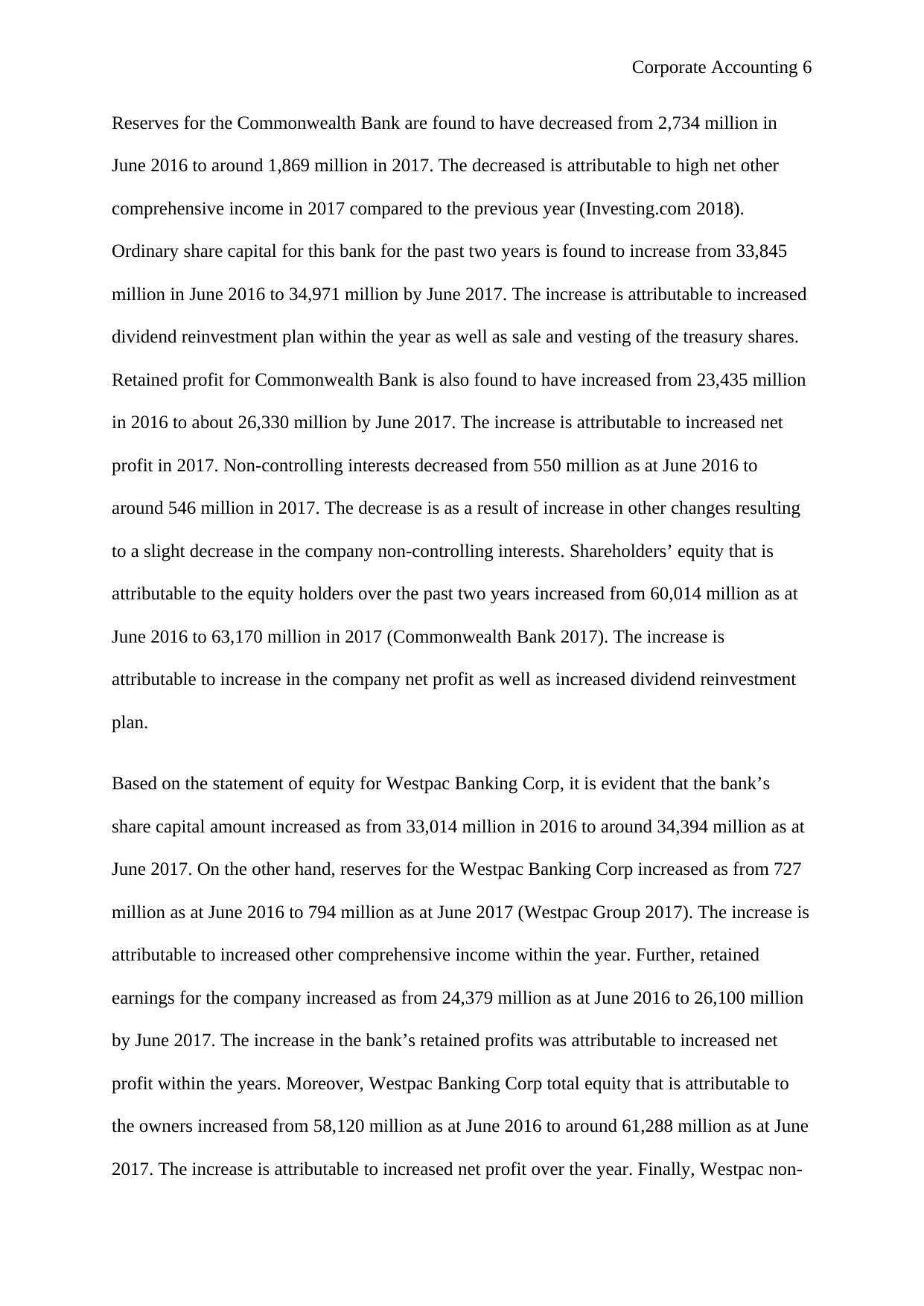
Corporate Accounting 6
Reserves for the Commonwealth Bank are found to have decreased from 2,734 million in
June 2016 to around 1,869 million in 2017. The decreased is attributable to high net other
comprehensive income in 2017 compared to the previous year (Investing.com 2018).
Ordinary share capital for this bank for the past two years is found to increase from 33,845
million in June 2016 to 34,971 million by June 2017. The increase is attributable to increased
dividend reinvestment plan within the year as well as sale and vesting of the treasury shares.
Retained profit for Commonwealth Bank is also found to have increased from 23,435 million
in 2016 to about 26,330 million by June 2017. The increase is attributable to increased net
profit in 2017. Non-controlling interests decreased from 550 million as at June 2016 to
around 546 million in 2017. The decrease is as a result of increase in other changes resulting
to a slight decrease in the company non-controlling interests. Shareholders’ equity that is
attributable to the equity holders over the past two years increased from 60,014 million as at
June 2016 to 63,170 million in 2017 (Commonwealth Bank 2017). The increase is
attributable to increase in the company net profit as well as increased dividend reinvestment
plan.
Based on the statement of equity for Westpac Banking Corp, it is evident that the bank’s
share capital amount increased as from 33,014 million in 2016 to around 34,394 million as at
June 2017. On the other hand, reserves for the Westpac Banking Corp increased as from 727
million as at June 2016 to 794 million as at June 2017 (Westpac Group 2017). The increase is
attributable to increased other comprehensive income within the year. Further, retained
earnings for the company increased as from 24,379 million as at June 2016 to 26,100 million
by June 2017. The increase in the bank’s retained profits was attributable to increased net
profit within the years. Moreover, Westpac Banking Corp total equity that is attributable to
the owners increased from 58,120 million as at June 2016 to around 61,288 million as at June
2017. The increase is attributable to increased net profit over the year. Finally, Westpac non-
Reserves for the Commonwealth Bank are found to have decreased from 2,734 million in
June 2016 to around 1,869 million in 2017. The decreased is attributable to high net other
comprehensive income in 2017 compared to the previous year (Investing.com 2018).
Ordinary share capital for this bank for the past two years is found to increase from 33,845
million in June 2016 to 34,971 million by June 2017. The increase is attributable to increased
dividend reinvestment plan within the year as well as sale and vesting of the treasury shares.
Retained profit for Commonwealth Bank is also found to have increased from 23,435 million
in 2016 to about 26,330 million by June 2017. The increase is attributable to increased net
profit in 2017. Non-controlling interests decreased from 550 million as at June 2016 to
around 546 million in 2017. The decrease is as a result of increase in other changes resulting
to a slight decrease in the company non-controlling interests. Shareholders’ equity that is
attributable to the equity holders over the past two years increased from 60,014 million as at
June 2016 to 63,170 million in 2017 (Commonwealth Bank 2017). The increase is
attributable to increase in the company net profit as well as increased dividend reinvestment
plan.
Based on the statement of equity for Westpac Banking Corp, it is evident that the bank’s
share capital amount increased as from 33,014 million in 2016 to around 34,394 million as at
June 2017. On the other hand, reserves for the Westpac Banking Corp increased as from 727
million as at June 2016 to 794 million as at June 2017 (Westpac Group 2017). The increase is
attributable to increased other comprehensive income within the year. Further, retained
earnings for the company increased as from 24,379 million as at June 2016 to 26,100 million
by June 2017. The increase in the bank’s retained profits was attributable to increased net
profit within the years. Moreover, Westpac Banking Corp total equity that is attributable to
the owners increased from 58,120 million as at June 2016 to around 61,288 million as at June
2017. The increase is attributable to increased net profit over the year. Finally, Westpac non-
⊘ This is a preview!⊘
Do you want full access?
Subscribe today to unlock all pages.

Trusted by 1+ million students worldwide
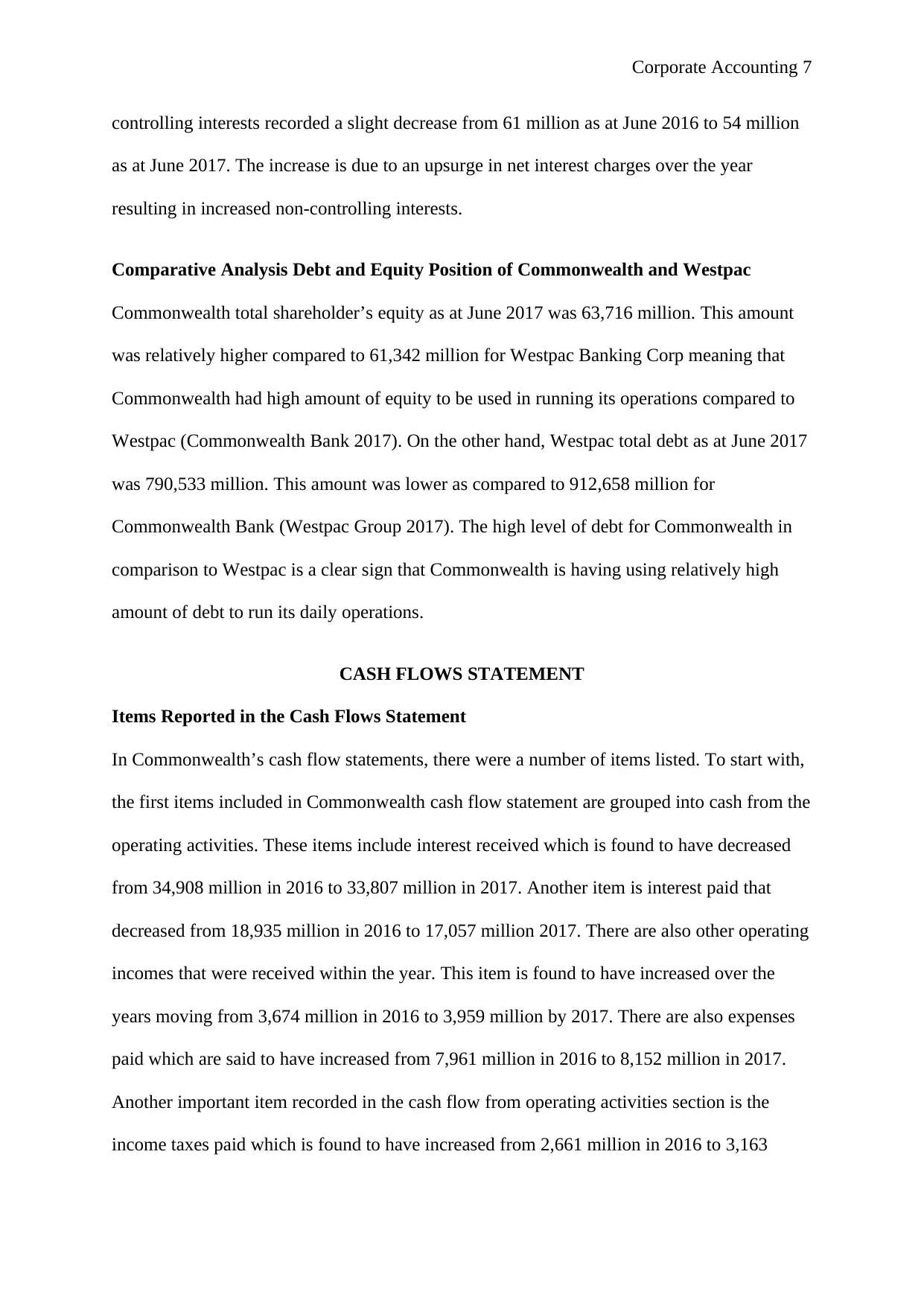
Corporate Accounting 7
controlling interests recorded a slight decrease from 61 million as at June 2016 to 54 million
as at June 2017. The increase is due to an upsurge in net interest charges over the year
resulting in increased non-controlling interests.
Comparative Analysis Debt and Equity Position of Commonwealth and Westpac
Commonwealth total shareholder’s equity as at June 2017 was 63,716 million. This amount
was relatively higher compared to 61,342 million for Westpac Banking Corp meaning that
Commonwealth had high amount of equity to be used in running its operations compared to
Westpac (Commonwealth Bank 2017). On the other hand, Westpac total debt as at June 2017
was 790,533 million. This amount was lower as compared to 912,658 million for
Commonwealth Bank (Westpac Group 2017). The high level of debt for Commonwealth in
comparison to Westpac is a clear sign that Commonwealth is having using relatively high
amount of debt to run its daily operations.
CASH FLOWS STATEMENT
Items Reported in the Cash Flows Statement
In Commonwealth’s cash flow statements, there were a number of items listed. To start with,
the first items included in Commonwealth cash flow statement are grouped into cash from the
operating activities. These items include interest received which is found to have decreased
from 34,908 million in 2016 to 33,807 million in 2017. Another item is interest paid that
decreased from 18,935 million in 2016 to 17,057 million 2017. There are also other operating
incomes that were received within the year. This item is found to have increased over the
years moving from 3,674 million in 2016 to 3,959 million by 2017. There are also expenses
paid which are said to have increased from 7,961 million in 2016 to 8,152 million in 2017.
Another important item recorded in the cash flow from operating activities section is the
income taxes paid which is found to have increased from 2,661 million in 2016 to 3,163
controlling interests recorded a slight decrease from 61 million as at June 2016 to 54 million
as at June 2017. The increase is due to an upsurge in net interest charges over the year
resulting in increased non-controlling interests.
Comparative Analysis Debt and Equity Position of Commonwealth and Westpac
Commonwealth total shareholder’s equity as at June 2017 was 63,716 million. This amount
was relatively higher compared to 61,342 million for Westpac Banking Corp meaning that
Commonwealth had high amount of equity to be used in running its operations compared to
Westpac (Commonwealth Bank 2017). On the other hand, Westpac total debt as at June 2017
was 790,533 million. This amount was lower as compared to 912,658 million for
Commonwealth Bank (Westpac Group 2017). The high level of debt for Commonwealth in
comparison to Westpac is a clear sign that Commonwealth is having using relatively high
amount of debt to run its daily operations.
CASH FLOWS STATEMENT
Items Reported in the Cash Flows Statement
In Commonwealth’s cash flow statements, there were a number of items listed. To start with,
the first items included in Commonwealth cash flow statement are grouped into cash from the
operating activities. These items include interest received which is found to have decreased
from 34,908 million in 2016 to 33,807 million in 2017. Another item is interest paid that
decreased from 18,935 million in 2016 to 17,057 million 2017. There are also other operating
incomes that were received within the year. This item is found to have increased over the
years moving from 3,674 million in 2016 to 3,959 million by 2017. There are also expenses
paid which are said to have increased from 7,961 million in 2016 to 8,152 million in 2017.
Another important item recorded in the cash flow from operating activities section is the
income taxes paid which is found to have increased from 2,661 million in 2016 to 3,163
Paraphrase This Document
Need a fresh take? Get an instant paraphrase of this document with our AI Paraphraser
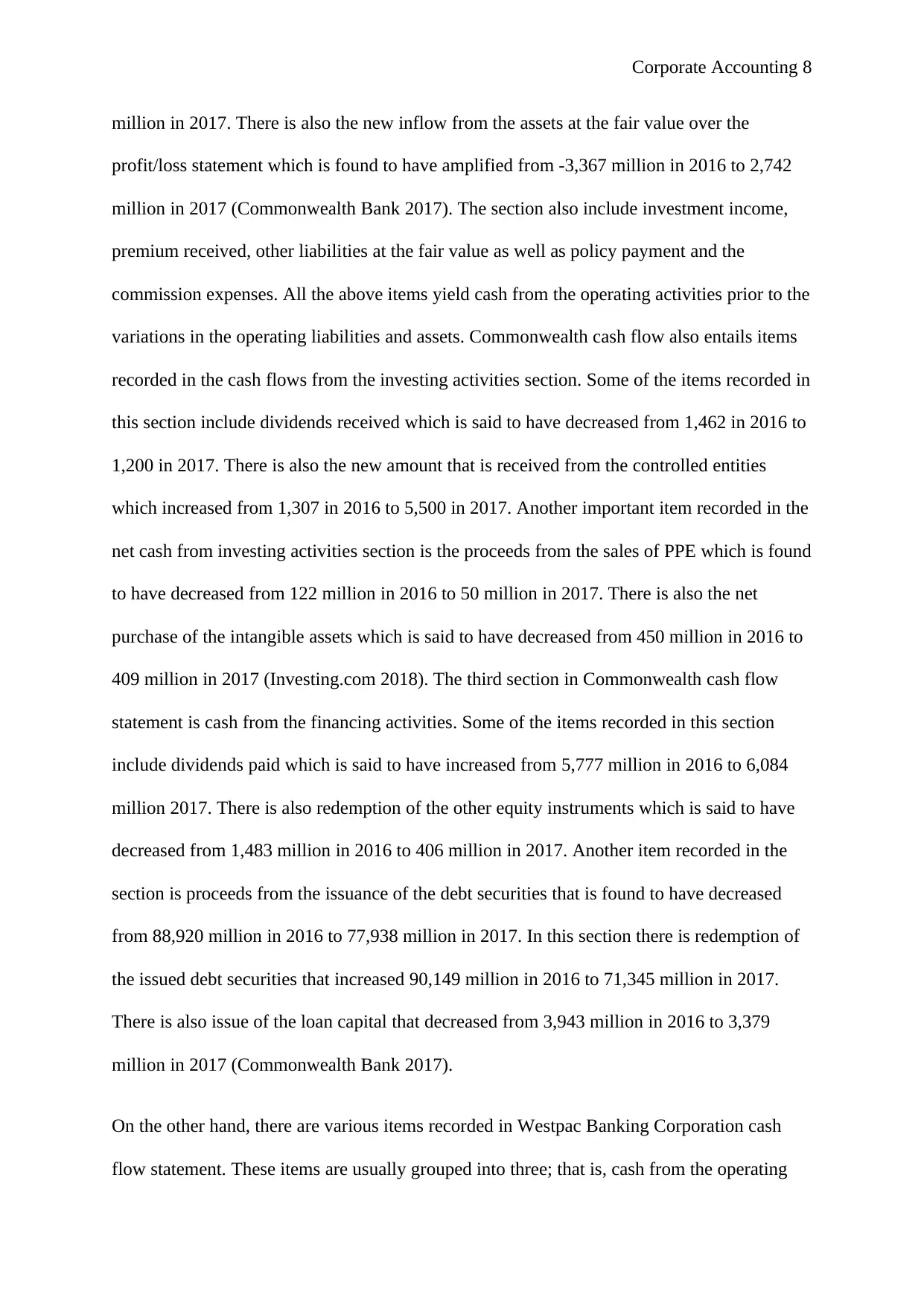
Corporate Accounting 8
million in 2017. There is also the new inflow from the assets at the fair value over the
profit/loss statement which is found to have amplified from -3,367 million in 2016 to 2,742
million in 2017 (Commonwealth Bank 2017). The section also include investment income,
premium received, other liabilities at the fair value as well as policy payment and the
commission expenses. All the above items yield cash from the operating activities prior to the
variations in the operating liabilities and assets. Commonwealth cash flow also entails items
recorded in the cash flows from the investing activities section. Some of the items recorded in
this section include dividends received which is said to have decreased from 1,462 in 2016 to
1,200 in 2017. There is also the new amount that is received from the controlled entities
which increased from 1,307 in 2016 to 5,500 in 2017. Another important item recorded in the
net cash from investing activities section is the proceeds from the sales of PPE which is found
to have decreased from 122 million in 2016 to 50 million in 2017. There is also the net
purchase of the intangible assets which is said to have decreased from 450 million in 2016 to
409 million in 2017 (Investing.com 2018). The third section in Commonwealth cash flow
statement is cash from the financing activities. Some of the items recorded in this section
include dividends paid which is said to have increased from 5,777 million in 2016 to 6,084
million 2017. There is also redemption of the other equity instruments which is said to have
decreased from 1,483 million in 2016 to 406 million in 2017. Another item recorded in the
section is proceeds from the issuance of the debt securities that is found to have decreased
from 88,920 million in 2016 to 77,938 million in 2017. In this section there is redemption of
the issued debt securities that increased 90,149 million in 2016 to 71,345 million in 2017.
There is also issue of the loan capital that decreased from 3,943 million in 2016 to 3,379
million in 2017 (Commonwealth Bank 2017).
On the other hand, there are various items recorded in Westpac Banking Corporation cash
flow statement. These items are usually grouped into three; that is, cash from the operating
million in 2017. There is also the new inflow from the assets at the fair value over the
profit/loss statement which is found to have amplified from -3,367 million in 2016 to 2,742
million in 2017 (Commonwealth Bank 2017). The section also include investment income,
premium received, other liabilities at the fair value as well as policy payment and the
commission expenses. All the above items yield cash from the operating activities prior to the
variations in the operating liabilities and assets. Commonwealth cash flow also entails items
recorded in the cash flows from the investing activities section. Some of the items recorded in
this section include dividends received which is said to have decreased from 1,462 in 2016 to
1,200 in 2017. There is also the new amount that is received from the controlled entities
which increased from 1,307 in 2016 to 5,500 in 2017. Another important item recorded in the
net cash from investing activities section is the proceeds from the sales of PPE which is found
to have decreased from 122 million in 2016 to 50 million in 2017. There is also the net
purchase of the intangible assets which is said to have decreased from 450 million in 2016 to
409 million in 2017 (Investing.com 2018). The third section in Commonwealth cash flow
statement is cash from the financing activities. Some of the items recorded in this section
include dividends paid which is said to have increased from 5,777 million in 2016 to 6,084
million 2017. There is also redemption of the other equity instruments which is said to have
decreased from 1,483 million in 2016 to 406 million in 2017. Another item recorded in the
section is proceeds from the issuance of the debt securities that is found to have decreased
from 88,920 million in 2016 to 77,938 million in 2017. In this section there is redemption of
the issued debt securities that increased 90,149 million in 2016 to 71,345 million in 2017.
There is also issue of the loan capital that decreased from 3,943 million in 2016 to 3,379
million in 2017 (Commonwealth Bank 2017).
On the other hand, there are various items recorded in Westpac Banking Corporation cash
flow statement. These items are usually grouped into three; that is, cash from the operating
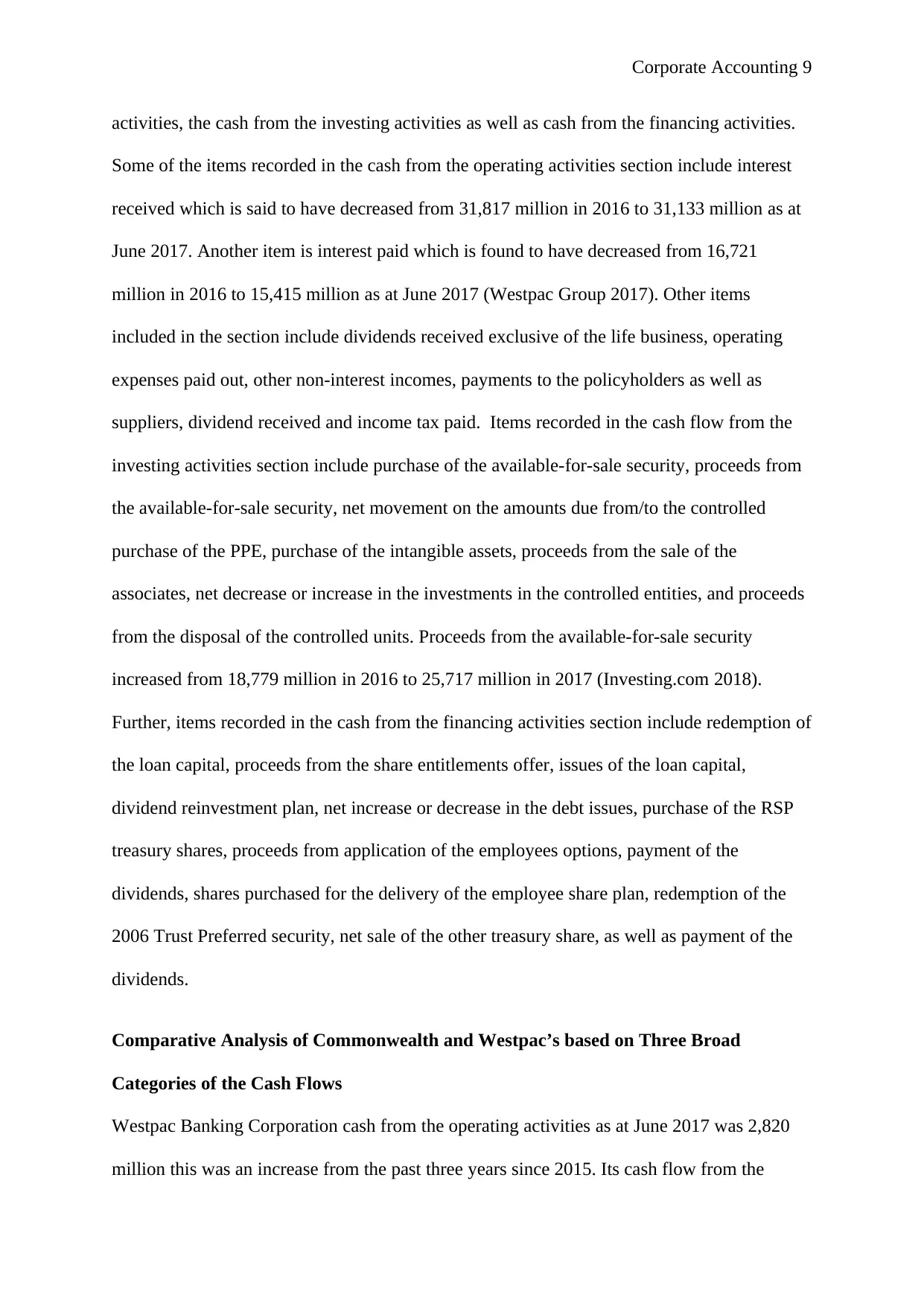
Corporate Accounting 9
activities, the cash from the investing activities as well as cash from the financing activities.
Some of the items recorded in the cash from the operating activities section include interest
received which is said to have decreased from 31,817 million in 2016 to 31,133 million as at
June 2017. Another item is interest paid which is found to have decreased from 16,721
million in 2016 to 15,415 million as at June 2017 (Westpac Group 2017). Other items
included in the section include dividends received exclusive of the life business, operating
expenses paid out, other non-interest incomes, payments to the policyholders as well as
suppliers, dividend received and income tax paid. Items recorded in the cash flow from the
investing activities section include purchase of the available-for-sale security, proceeds from
the available-for-sale security, net movement on the amounts due from/to the controlled
purchase of the PPE, purchase of the intangible assets, proceeds from the sale of the
associates, net decrease or increase in the investments in the controlled entities, and proceeds
from the disposal of the controlled units. Proceeds from the available-for-sale security
increased from 18,779 million in 2016 to 25,717 million in 2017 (Investing.com 2018).
Further, items recorded in the cash from the financing activities section include redemption of
the loan capital, proceeds from the share entitlements offer, issues of the loan capital,
dividend reinvestment plan, net increase or decrease in the debt issues, purchase of the RSP
treasury shares, proceeds from application of the employees options, payment of the
dividends, shares purchased for the delivery of the employee share plan, redemption of the
2006 Trust Preferred security, net sale of the other treasury share, as well as payment of the
dividends.
Comparative Analysis of Commonwealth and Westpac’s based on Three Broad
Categories of the Cash Flows
Westpac Banking Corporation cash from the operating activities as at June 2017 was 2,820
million this was an increase from the past three years since 2015. Its cash flow from the
activities, the cash from the investing activities as well as cash from the financing activities.
Some of the items recorded in the cash from the operating activities section include interest
received which is said to have decreased from 31,817 million in 2016 to 31,133 million as at
June 2017. Another item is interest paid which is found to have decreased from 16,721
million in 2016 to 15,415 million as at June 2017 (Westpac Group 2017). Other items
included in the section include dividends received exclusive of the life business, operating
expenses paid out, other non-interest incomes, payments to the policyholders as well as
suppliers, dividend received and income tax paid. Items recorded in the cash flow from the
investing activities section include purchase of the available-for-sale security, proceeds from
the available-for-sale security, net movement on the amounts due from/to the controlled
purchase of the PPE, purchase of the intangible assets, proceeds from the sale of the
associates, net decrease or increase in the investments in the controlled entities, and proceeds
from the disposal of the controlled units. Proceeds from the available-for-sale security
increased from 18,779 million in 2016 to 25,717 million in 2017 (Investing.com 2018).
Further, items recorded in the cash from the financing activities section include redemption of
the loan capital, proceeds from the share entitlements offer, issues of the loan capital,
dividend reinvestment plan, net increase or decrease in the debt issues, purchase of the RSP
treasury shares, proceeds from application of the employees options, payment of the
dividends, shares purchased for the delivery of the employee share plan, redemption of the
2006 Trust Preferred security, net sale of the other treasury share, as well as payment of the
dividends.
Comparative Analysis of Commonwealth and Westpac’s based on Three Broad
Categories of the Cash Flows
Westpac Banking Corporation cash from the operating activities as at June 2017 was 2,820
million this was an increase from the past three years since 2015. Its cash flow from the
⊘ This is a preview!⊘
Do you want full access?
Subscribe today to unlock all pages.

Trusted by 1+ million students worldwide
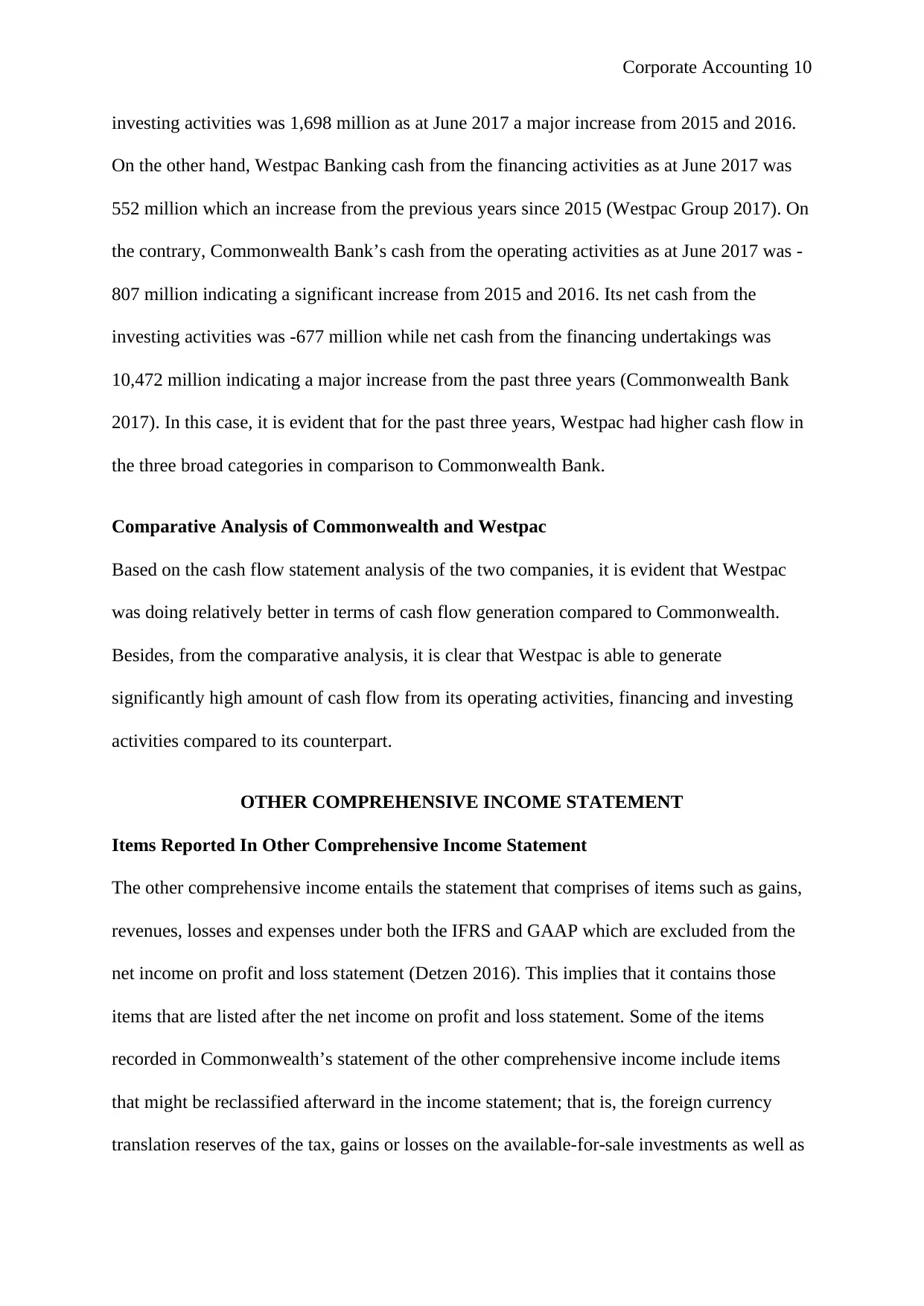
Corporate Accounting 10
investing activities was 1,698 million as at June 2017 a major increase from 2015 and 2016.
On the other hand, Westpac Banking cash from the financing activities as at June 2017 was
552 million which an increase from the previous years since 2015 (Westpac Group 2017). On
the contrary, Commonwealth Bank’s cash from the operating activities as at June 2017 was -
807 million indicating a significant increase from 2015 and 2016. Its net cash from the
investing activities was -677 million while net cash from the financing undertakings was
10,472 million indicating a major increase from the past three years (Commonwealth Bank
2017). In this case, it is evident that for the past three years, Westpac had higher cash flow in
the three broad categories in comparison to Commonwealth Bank.
Comparative Analysis of Commonwealth and Westpac
Based on the cash flow statement analysis of the two companies, it is evident that Westpac
was doing relatively better in terms of cash flow generation compared to Commonwealth.
Besides, from the comparative analysis, it is clear that Westpac is able to generate
significantly high amount of cash flow from its operating activities, financing and investing
activities compared to its counterpart.
OTHER COMPREHENSIVE INCOME STATEMENT
Items Reported In Other Comprehensive Income Statement
The other comprehensive income entails the statement that comprises of items such as gains,
revenues, losses and expenses under both the IFRS and GAAP which are excluded from the
net income on profit and loss statement (Detzen 2016). This implies that it contains those
items that are listed after the net income on profit and loss statement. Some of the items
recorded in Commonwealth’s statement of the other comprehensive income include items
that might be reclassified afterward in the income statement; that is, the foreign currency
translation reserves of the tax, gains or losses on the available-for-sale investments as well as
investing activities was 1,698 million as at June 2017 a major increase from 2015 and 2016.
On the other hand, Westpac Banking cash from the financing activities as at June 2017 was
552 million which an increase from the previous years since 2015 (Westpac Group 2017). On
the contrary, Commonwealth Bank’s cash from the operating activities as at June 2017 was -
807 million indicating a significant increase from 2015 and 2016. Its net cash from the
investing activities was -677 million while net cash from the financing undertakings was
10,472 million indicating a major increase from the past three years (Commonwealth Bank
2017). In this case, it is evident that for the past three years, Westpac had higher cash flow in
the three broad categories in comparison to Commonwealth Bank.
Comparative Analysis of Commonwealth and Westpac
Based on the cash flow statement analysis of the two companies, it is evident that Westpac
was doing relatively better in terms of cash flow generation compared to Commonwealth.
Besides, from the comparative analysis, it is clear that Westpac is able to generate
significantly high amount of cash flow from its operating activities, financing and investing
activities compared to its counterpart.
OTHER COMPREHENSIVE INCOME STATEMENT
Items Reported In Other Comprehensive Income Statement
The other comprehensive income entails the statement that comprises of items such as gains,
revenues, losses and expenses under both the IFRS and GAAP which are excluded from the
net income on profit and loss statement (Detzen 2016). This implies that it contains those
items that are listed after the net income on profit and loss statement. Some of the items
recorded in Commonwealth’s statement of the other comprehensive income include items
that might be reclassified afterward in the income statement; that is, the foreign currency
translation reserves of the tax, gains or losses on the available-for-sale investments as well as
Paraphrase This Document
Need a fresh take? Get an instant paraphrase of this document with our AI Paraphraser
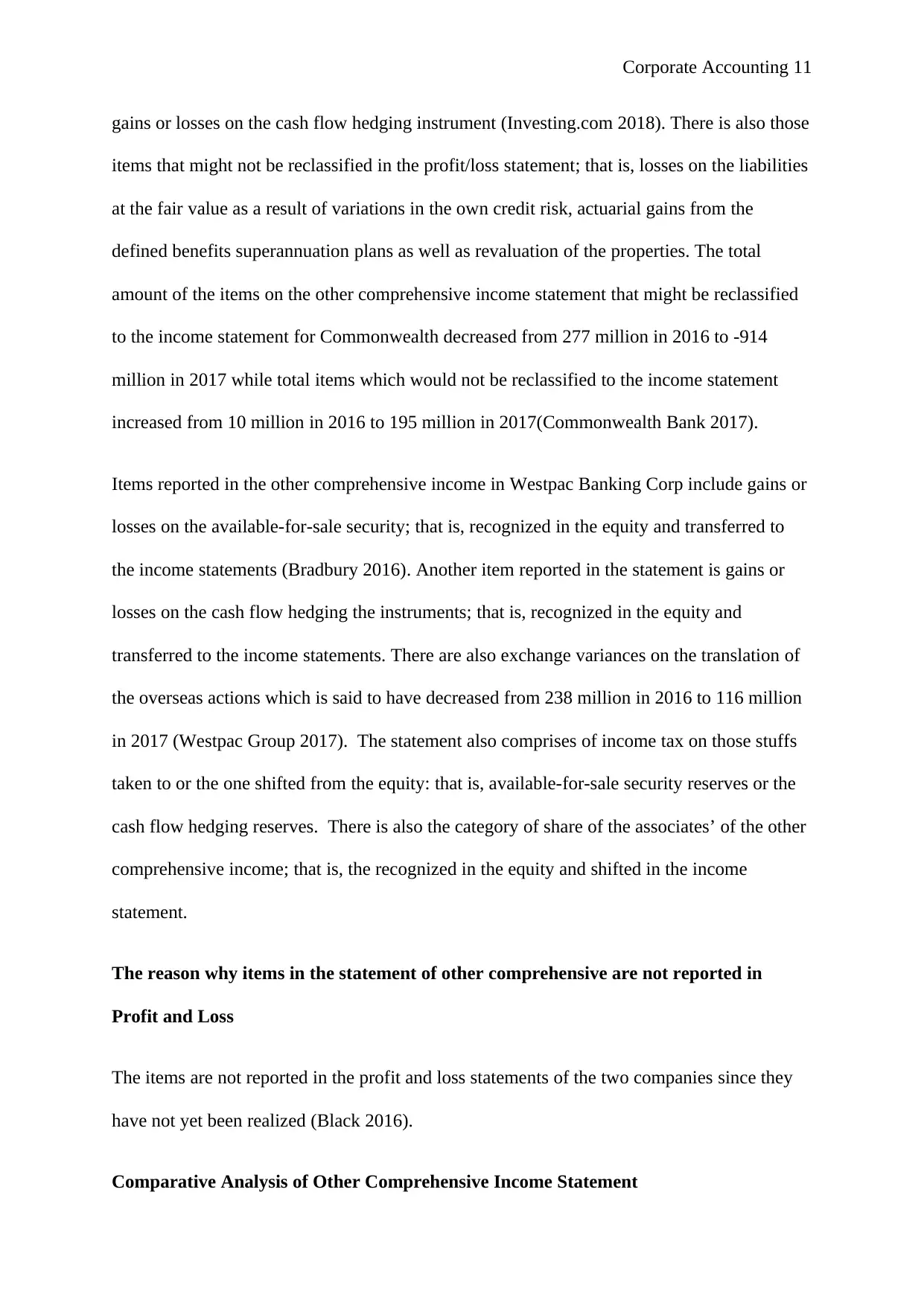
Corporate Accounting 11
gains or losses on the cash flow hedging instrument (Investing.com 2018). There is also those
items that might not be reclassified in the profit/loss statement; that is, losses on the liabilities
at the fair value as a result of variations in the own credit risk, actuarial gains from the
defined benefits superannuation plans as well as revaluation of the properties. The total
amount of the items on the other comprehensive income statement that might be reclassified
to the income statement for Commonwealth decreased from 277 million in 2016 to -914
million in 2017 while total items which would not be reclassified to the income statement
increased from 10 million in 2016 to 195 million in 2017(Commonwealth Bank 2017).
Items reported in the other comprehensive income in Westpac Banking Corp include gains or
losses on the available-for-sale security; that is, recognized in the equity and transferred to
the income statements (Bradbury 2016). Another item reported in the statement is gains or
losses on the cash flow hedging the instruments; that is, recognized in the equity and
transferred to the income statements. There are also exchange variances on the translation of
the overseas actions which is said to have decreased from 238 million in 2016 to 116 million
in 2017 (Westpac Group 2017). The statement also comprises of income tax on those stuffs
taken to or the one shifted from the equity: that is, available-for-sale security reserves or the
cash flow hedging reserves. There is also the category of share of the associates’ of the other
comprehensive income; that is, the recognized in the equity and shifted in the income
statement.
The reason why items in the statement of other comprehensive are not reported in
Profit and Loss
The items are not reported in the profit and loss statements of the two companies since they
have not yet been realized (Black 2016).
Comparative Analysis of Other Comprehensive Income Statement
gains or losses on the cash flow hedging instrument (Investing.com 2018). There is also those
items that might not be reclassified in the profit/loss statement; that is, losses on the liabilities
at the fair value as a result of variations in the own credit risk, actuarial gains from the
defined benefits superannuation plans as well as revaluation of the properties. The total
amount of the items on the other comprehensive income statement that might be reclassified
to the income statement for Commonwealth decreased from 277 million in 2016 to -914
million in 2017 while total items which would not be reclassified to the income statement
increased from 10 million in 2016 to 195 million in 2017(Commonwealth Bank 2017).
Items reported in the other comprehensive income in Westpac Banking Corp include gains or
losses on the available-for-sale security; that is, recognized in the equity and transferred to
the income statements (Bradbury 2016). Another item reported in the statement is gains or
losses on the cash flow hedging the instruments; that is, recognized in the equity and
transferred to the income statements. There are also exchange variances on the translation of
the overseas actions which is said to have decreased from 238 million in 2016 to 116 million
in 2017 (Westpac Group 2017). The statement also comprises of income tax on those stuffs
taken to or the one shifted from the equity: that is, available-for-sale security reserves or the
cash flow hedging reserves. There is also the category of share of the associates’ of the other
comprehensive income; that is, the recognized in the equity and shifted in the income
statement.
The reason why items in the statement of other comprehensive are not reported in
Profit and Loss
The items are not reported in the profit and loss statements of the two companies since they
have not yet been realized (Black 2016).
Comparative Analysis of Other Comprehensive Income Statement
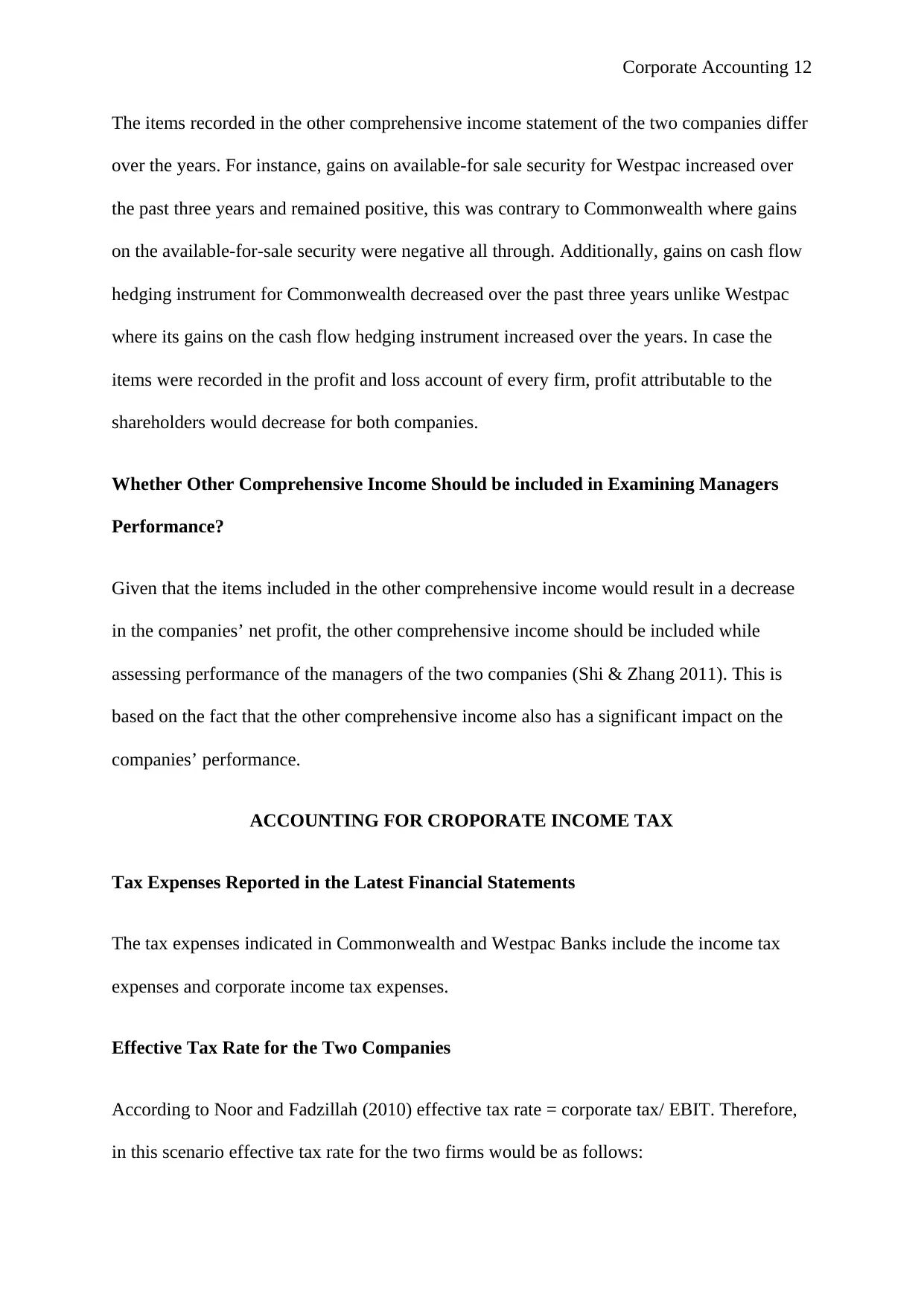
Corporate Accounting 12
The items recorded in the other comprehensive income statement of the two companies differ
over the years. For instance, gains on available-for sale security for Westpac increased over
the past three years and remained positive, this was contrary to Commonwealth where gains
on the available-for-sale security were negative all through. Additionally, gains on cash flow
hedging instrument for Commonwealth decreased over the past three years unlike Westpac
where its gains on the cash flow hedging instrument increased over the years. In case the
items were recorded in the profit and loss account of every firm, profit attributable to the
shareholders would decrease for both companies.
Whether Other Comprehensive Income Should be included in Examining Managers
Performance?
Given that the items included in the other comprehensive income would result in a decrease
in the companies’ net profit, the other comprehensive income should be included while
assessing performance of the managers of the two companies (Shi & Zhang 2011). This is
based on the fact that the other comprehensive income also has a significant impact on the
companies’ performance.
ACCOUNTING FOR CROPORATE INCOME TAX
Tax Expenses Reported in the Latest Financial Statements
The tax expenses indicated in Commonwealth and Westpac Banks include the income tax
expenses and corporate income tax expenses.
Effective Tax Rate for the Two Companies
According to Noor and Fadzillah (2010) effective tax rate = corporate tax/ EBIT. Therefore,
in this scenario effective tax rate for the two firms would be as follows:
The items recorded in the other comprehensive income statement of the two companies differ
over the years. For instance, gains on available-for sale security for Westpac increased over
the past three years and remained positive, this was contrary to Commonwealth where gains
on the available-for-sale security were negative all through. Additionally, gains on cash flow
hedging instrument for Commonwealth decreased over the past three years unlike Westpac
where its gains on the cash flow hedging instrument increased over the years. In case the
items were recorded in the profit and loss account of every firm, profit attributable to the
shareholders would decrease for both companies.
Whether Other Comprehensive Income Should be included in Examining Managers
Performance?
Given that the items included in the other comprehensive income would result in a decrease
in the companies’ net profit, the other comprehensive income should be included while
assessing performance of the managers of the two companies (Shi & Zhang 2011). This is
based on the fact that the other comprehensive income also has a significant impact on the
companies’ performance.
ACCOUNTING FOR CROPORATE INCOME TAX
Tax Expenses Reported in the Latest Financial Statements
The tax expenses indicated in Commonwealth and Westpac Banks include the income tax
expenses and corporate income tax expenses.
Effective Tax Rate for the Two Companies
According to Noor and Fadzillah (2010) effective tax rate = corporate tax/ EBIT. Therefore,
in this scenario effective tax rate for the two firms would be as follows:
⊘ This is a preview!⊘
Do you want full access?
Subscribe today to unlock all pages.

Trusted by 1+ million students worldwide
1 out of 17
Related Documents
Your All-in-One AI-Powered Toolkit for Academic Success.
+13062052269
info@desklib.com
Available 24*7 on WhatsApp / Email
![[object Object]](/_next/static/media/star-bottom.7253800d.svg)
Unlock your academic potential
Copyright © 2020–2025 A2Z Services. All Rights Reserved. Developed and managed by ZUCOL.





